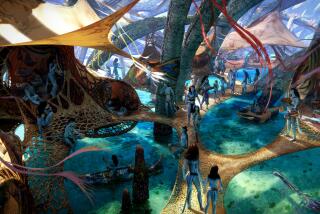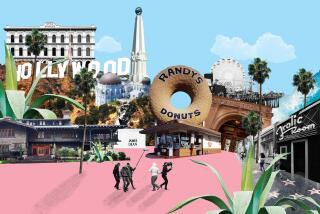What happened when Baz Luhrmann moved ‘The Great Gatsby’ to Australia
F. Scott Fitzgerald’s ambition for “The Great Gatsby” was scarcely modest: “Something new — something extraordinary and beautiful and simple and intricately patterned,” the novelist wrote to his editor of his plans for the 1925 novel.
Tobey Maguire, who stars as narrator Nick Carraway in director Baz Luhrmann’s big-screen adaptation of the classic, said the Australian filmmaker’s goal was no less cheeky. “Baz set out to do something very much like that,” Maguire said.
You could safely strike the word “simple” from Luhrmann’s plans, though.
PHOTOS: ‘The Great Gatsby’ premiere
Opening Thursday night, “The Great Gatsby” is Luhrmann’s long-in-the-works, half-year-delayed telling of what many consider the Great American Novel. Though the story is centered on New York, budget pressures prompted the production to relocate to Australia. The move, made after Luhrmann’s team had started scouting New York locations, created logistical quandaries — for instance, how do you find 1920s American cars with left-hand drive in Sydney?et
Still, Luhrmann believed the hemispheric shift had substantial upsides: focusing the film’s creative energies, allowing for more days of principal photography because shooting in Australia is cheaper than in New York, and providing the production the geographical distance to take more cinematic risks as Luhrmann tried to find the true heart of the novel.
“Baz is inspired by building an ensemble — he makes sure that every extra has some biographical information about who he or she is playing in a scene,” said producer Doug Wick. “In moving to Australia, it was like the ultimate art camp, where everybody is immersed in the 1920s and a day and a half away from the rest of their lives.”
Some deviations
Luhrmann’s “The Great Gatsby” closely tracks the novel’s central story lines: Bootlegger turned millionaire Jay Gatsby (Leonardo DiCaprio) is desperate to reconnect with former flame Daisy Buchanan (Carey Mulligan), who is married to a philandering, polo-playing blue blood, Tom (Joel Edgerton).
Observing all of the romantic and class entanglements with increasing contempt is Nick (Maguire), who was a college classmate of Tom’s and who happens to be Gatsby’s neighbor. The cast includes Australian actress Elizabeth Debicki as Nick’s girlfriend, Jordan Baker; Isla Fisher as Myrtle Wilson, with whom Tom is having an affair; and Jason Clarke as Myrtle’s husband, George.
Adapted by Luhrmann and longtime screenwriting partner Craig Pearce (“Romeo + Juliet,” “Moulin Rouge!”), the script creates a new framing device — Nick is writing “The Great Gatsby” as therapy for alcoholism — and does away with several scenes, mostly those that follow Gatsby’s death because Luhrmann felt they diffused the story. The film’s most notable deviations from the 1925 novel can be measured in scale.
PHOTOS: The Roaring ‘20s on-screen
On-screen, Gatsby’s famously extravagant parties are even more over-the-top than they are on the page and are magnified further by 3-D filming. The soundtrack features contemporary artists such as Lana Del Rey, will.i.am and Jay-Z and Gotye. And infidelities that are whispered in print become more explicit in the film.
“Fitzgerald couldn’t quite say, ‘Hey, they all took their clothes off and had sex,’” Luhrmann said of a scene between Tom and Myrtle in his New York love nest. “But when I read that scene, I thought, ‘They went crazy. It was an orgy — a wild, wild party.’” To make sure his actors were in the right mood for that scene, Luhrmann cranked Jay-Z and Kanye West’s “… in Paris” during filming.
Because the novel is thin on exposition, Luhrmann turned to an array of sources for inspiration and illumination.
When the lead actors were cast, about a year before filming commenced in summer 2011, Luhrmann gave them iPods loaded with period music — including compositions by Louis Armstrong and George Gershwin — and sent along Ken Burns’ documentary “Prohibition.” Mulligan was handed several biographies of Fitzgerald’s wife, Zelda, and letters the novelist wrote to his early love, Ginevra King. DiCaprio said he relied heavily on “Trimalchio,” Fitzgerald’s draft of “The Great Gatsby.”
“‘Trimalchio’ was almost like a bible for us on set. We referenced it constantly,” said DiCaprio, adding that the early version of the novel made Fitzgerald’s “intent shine more clearly through.” The actor didn’t find a kindhearted, lost soul there. As Mulligan said, “Leo took his characterization of Gatsby into more of a desperate, extreme place.”
Logistical challenges
When Luhrmann told his cast in mid-2011 that they were abandoning New York for Australia (the state’s film tax rebates had been largely exhausted by “Men in Black 3”), the actors were not sure what to make of the news.
VIDEO: ‘The Great Gatsby’ preview
“In truth, it was probably something like, ‘I wonder how we’re going to pull it off?’” Maguire said. “I was definitely thinking about how it would affect the look of the film and how we would make it work.”
The production designer, Catherine Martin — Luhrmann’s wife — had the same concerns. She and Luhrmann, who wanted to film in New York, had scouted several New York locations for the Buchanan estate (Old Westbury Gardens in Nassau County) and Gatsby’s mansion (Hempstead House, near Port Washington). Those structures, they thought, would need to be decorated in period style, but construction would be minimal.
When “The Great Gatsby” moved to Australia, it was an entirely different story.
Martin and her crew had to build numerous massive sets and create parts of the mansions through visual effects. Even the interior of the Plaza Hotel, where Jay and Tom have their famous quarrel over Daisy, had to be constructed on an Australian sound stage. (A “Great Gatsby” shot from the hotel toward Central Park actually was filmed in New York, inside designer Tommy Hilfiger’s apartment at the Plaza.)
To fill out its fleet of left-hand-drive cars, some of which were imported, the production would sometimes put a fake steering wheel on the left side, in front of an actor in a chauffeur costume, while an extra dressed as a footman on the right would actually be driving with a lowered steering wheel. “And we had to make sure people were driving on the right-hand side of the road, which can be really confusing,” said Martin.
To build the Valley of Ashes, the bleak industrial wasteland that’s home to the Wilsons’ service station (in present-day Queens), the production found an abandoned railroad yard, not far from where Luhrmann shot his first feature, “Strictly Ballroom,” and trucked in tons of ashes.
Martin says “The Great Gatsby” would have been a completely different movie had it been shot stateside, though it’s tough for her to articulate exactly what would have changed. “I just think they are completely different beasts.” Still, she added, “I would really love to have the experience of shooting in New York one day.”
PHOTOS AND MORE
Roger Ebert: Career in pictures
ENVELOPE: The latest awards buzz
PHOTOS: Greatest box office flops
More to Read
Only good movies
Get the Indie Focus newsletter, Mark Olsen's weekly guide to the world of cinema.
You may occasionally receive promotional content from the Los Angeles Times.











